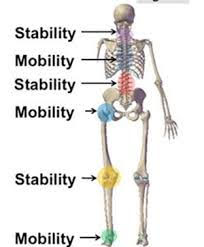Back pain is not something you can just “work through”. If you are suffering from back pain you must identify what movements or compensation patterns are causing or contributing to your pain, then remove them.
In general, your exercise program or corrective strategy should cause no increase in pain during or after. Furthermore—in my experience—removing the daily habits and tendencies that are contributing to your pain and dysfunction will have a major impact on managing and/or relieving your pain symptoms. If you want to read more about strategies to address your low back pain, read this.
Next I strongly encourage you to understand what core stability actually means.
True spinal stability is achieved when the surrounding musculature is able to provide the appropriate tension and control while we move through various movements. This is a balance of having the right muscles working with the appropriate amount of tension, as well as having the movement coming from the right places. If you want to learn more about my recommendations on core training, read this. you can read about that HERE.
To further understand this concept of mobility and/or stability of joints I am going to lean on the joint by joint approach. This a concept that was introduced by Gray Cook, co-founder of the Functional Movement Systems.

- The foot: stability and motor control.
- The ankle: mobility and flexibility.
- The knee: stability and motor control.
- The hip: mobility and flexibility.
- The lumbar and sacral region: stability and motor control.
- The thoracic region mobility and flexibility.
- The middle and lower cervical regions stability and motor control.
- The upper cervical region mobility and flexibility.
- The shoulder scapular region stability and motor control.
- The shoulder joint mobility and flexibility.
As you can see from this model, our body is designed to concentrate on stability and/or mobility, based on specific joints. The lower spine (the lumbar and sacral region) is reserved for stability and motor control. Whereas, the mid back or thoracic region relies on mobility for ideal function. Another important concept to appreciate is if you don’t have mobility in a particular area than your body will find it elsewhere and that is often at the expense of another joint’s stability. This is why we spend a lot of time on ensuring that our clients have good mobility of their thoracic spine in flexion, extension, and rotation. We do the same for hip mobility, which you can read more about HERE. This ultimately helps to save the low back from being the brunt of compensation.
Below are three of our favourite drills that we use to improve thoracic mobility.
T-Spine Prayer
The focus of this exercise is to improve thoracic extension.
Coaching Cues:
- Hold on to a stick or a dowel as this will prevent your shoulders from going in to internal rotation, which will help this movement to serve as a lat stretch as well
- Exhale as you go into the prayer position
- If you do not feel a stretch in your mid back or lats then move your knees further away from the bench. If you only feel the stretch in your lats, move your knees closer to the bench
- Complete 5-10 reps as part of your warm up, in between sets, or anytime throughout the day
Cat and Camel
The focus of this exercise is to mobilize your thoracic spine and to move into your full range of thoracic flexion and extension, along with lumbar flexion and extension. As an added bonus if you focus on articulating each spinal segment you can further work on segmental control and stability at the same time.
Coaching Cues:
- Inhale as you round up and exhale as you arch down
- Aim to start at your pelvis/sacrum region and slowly, in an orderly fashion round your entire spine, reverse the motion. Most people will have area that are hard to find movement or control – these are the areas you need to work on
- If you are really stuck (pun intended) you can try standing against a wall, that way you have something to articulate your spine against or away
Side Lying Rib Grabs
This exercise is to help improve thoracic rotation.
Coaching Cues:
- It is helpful to stretch your lats and do one or both of the above extension drills, as this can enable you to access more potential rotation
- Avoid setting up in a fetal position and try to have your spine straight (hips and shoulders aligned)
- Make sure your top knee is at hip height and place it on a block or foam roll. Both of these will help ensure that you do NOT rotate through your lumbar spine
- Exhale as your rotate and try to stay tall
- Avoid rotating down, try your best to stay on a horizontal path
If you are currently suffering from back pain or are looking for a program that will specifically target/help improve your spinal health, you can book in for a fitness assessment here.
Please comment if you have any questions.
Andrea





